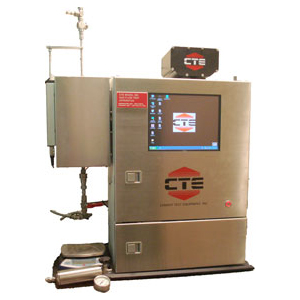M300

Gas Migration Apparatus
Model #: M300
Description
The CTE model 300 gas migration apparatus is used to determine the resistance to gas invasion or gas flow, of well cement slurry after placement in the well in accordance with the theories discussed in a Society of Petroleum Engineers paper SPE 24049. The instrument allows real time measurement of gas migration during the transition period, when the slurry is changing from a pumpable liquid to a solid. Annular fluid or gas migration can occur during drilling or well completion operations because of a pressure imbalance at the formation face. It manifests itself mainly by the appearance of gas at the top of the annulus or by interzonal gas flow in the wellbore. The severity of gas channeling ranges from the potential for a blowout situation when well control is lost because of severe pressure imbalance during drilling or cementing; to the most marginal, i.e. a residual gas pressure of a few psi at the wellhead.
Downloadables
Laboratory testing using the model 300 involves preparing a cement slurry and testing according to API Spec 10 or ISO 10426 for thickening time, free water, fluid loss and compressive strength. Maximum temperature is 400F (204C) and 2,000psi (13.7kPa). The model 300 test cell is fitted with screens or core material, and the slurry is poured into it. The cell is closed and placed into a temperature controlled housing for the test to begin. Nitrogen gas is applied to create hydraulic pressure. The apparatus consists of a long stainless steel cylinder to represent the well bore. The bottom of the cell is fitted with 325-mesh screenor core material of known permeability and connected to a pressure regulator to represent the low-pressure zone. The top of the cylinder consists of a head arrangement that allows a traveling piston fitted on another screen to represent the high pressure formation. An electronic pressure controller is used to apply overburden pressure to the top of the piston. Another pressure transducer is connected to the side of the test cell near the bottom to monitor the pressure representative of the cement column, as the test slurry changes during the setting process from liquid to solid.
The model 300 allows real time measurement of gas migration during the transitional period of setting cement. Key test parameters are continuously monitored and plotted, such as temperature, piston movement, balance output, slurry pore pressure, hydraulic pressure, formation gas flow, and formation gas pressure. We have incorporated an over-temperature safety feature into the instrument. This monitoring relay senses when the heater is receiving too much current and cuts power stopping a run-away heating situation. A safety pressure head is also incorporated into the instrument which carries a rupture disc that safely bursts in case an over pressure situation arises.
FEATURES
• Digital, self-tuning pressure and temperature control
• Stainless steel construction of all pressurized components
• Fully automatic control of hydraulic (overburden) pressure
• Powerful and smart CementLab V5 is used for data recording, printing, and analysis
• Simple export to text file for use in custom programs, databases, and spreadsheets
• Simulate a deviated well bore from 0 – 90 degrees
• Electronic balance with data acquisition and archiving
• 12” ELO touchscreen gives users more control over traditional computer systems
• Pressure rupture disc and current sensing relay provide over pressure and temperature run away safety controls
SPECIFICATIONS
AIR/N2 CONNECTIONS
Nitrogen Input: 1/4 MNPT
Air Input: 1/4 MNPT max 160psi
Nitrogen pressure: 3,000psig Max
ELECTRICAL
Input Voltage: 230 VAC (±10%)
Input Power: 900W
Current: 5A
Input Frequency: 50-60Hz
MECHANICAL
Height 29 in. (73.7 cm)
Width 29 in. (73.7 cm)
Depth 14 in. (35.6 cm)
Weight 150 lb (68 kg)
ENVIRONMENTAL
Operating Temp.: 32 to 105°F, 0-40°C
Operating Humidity: 0-95% non condensing
HEATER
Heater Power: 800 W
Heater Type: Cast Heater
ACCESSORIES
Supplied with a digital balance, power cord, printer, o-rings, screens, ASE wrenches, hoses and connectors to connect instrument to laboratory utilities.
